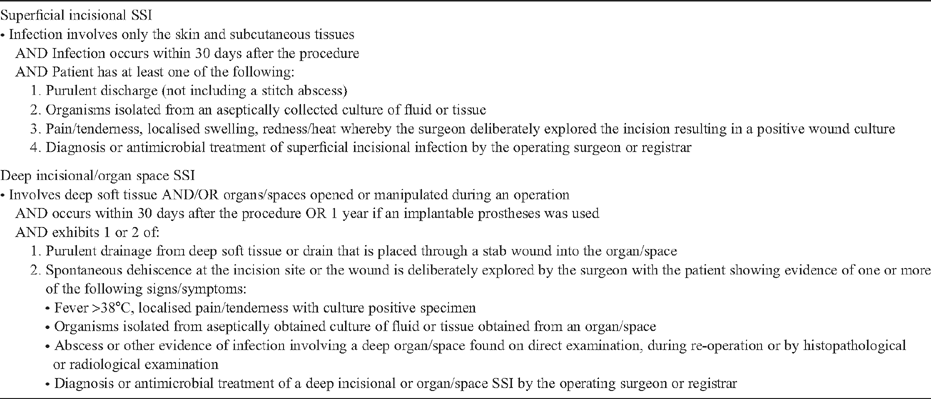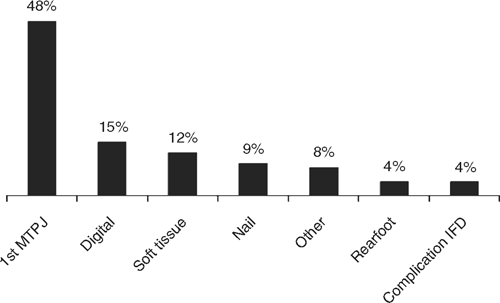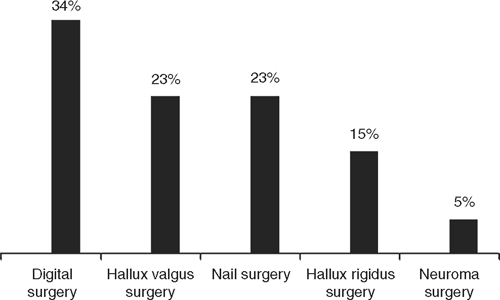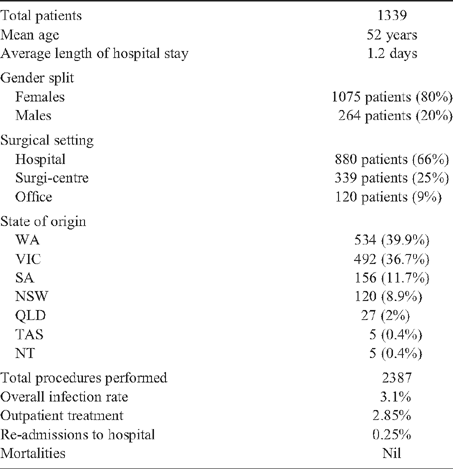Postoperative infection rates in foot and ankle surgery: a clinical audit of Australian podiatric surgeons, January to December 2007
Paul Butterworth A D , Mark F. Gilheany B and Paul Tinley CA La Trobe University Podiatry Clinic, Kingsbury Drive, Bundoora, VIC 3086, Australia.
B East Melbourne Podiatry, Suite 4, 2nd floor Landsdowne House, 182–184 Victoria Parade, East Melbourne, VIC 3004, Australia. Email: mgpod@alphalink.com.au
C School of Community Health, Faculty of Science, Charles Sturt University, PO Box 789, Albury, NSW 2640, Australia. Email: ptinley@csu.edu.au
D Corresponding author. Email: butters05@yahoo.com.au
Australian Health Review 34(2) 180-185 https://doi.org/10.1071/AH08687
Submitted: 1 September 2008 Accepted: 25 November 2009 Published: 25 May 2010
Abstract
Background. Surgical site infections are one of the most common post-operative complications encountered by foot and ankle surgeons. The incidence reported in the literature varies between 0.5 and 6.5%. The results of a 12-month Australia-wide clinical audit analysing the rates of postoperative infections in association with podiatric surgery are presented.
Methods. De-identified patient data was collected from nine podiatric surgeons Australia-wide. Infections were identified according to Australian Council on Health Care Standards (ACHS) definitions and data was entered no earlier than thirty days post procedure.
Results. A total of 1339 patient admissions and 2387 surgical procedures were reported using the International Classification of Diseases (ICD-10) and Medicare Benefit Schedule (MBS) coding systems. The overall infection rate was 3.1% and the rate of infection resulting in hospital re-admission was 0.25%.
Conclusions. The benchmark results presented in this paper suggest that infection rates associated with podiatric surgery are well within accepted industry standards as stated in recent literature.
What is known about the topic? The rates of infection in foot and ankle surgery have been reported in international literature to vary between 0.5 and 6.5%. No such data has been published to date, which describes the rate of infection following podiatric surgery in Australia.
What does this paper add? This paper provides benchmark data on complication rates associated with Australian podiatric surgeons. Such data also informs health and hospital managers who may be considering podiatric surgery as an option for providing foot surgery services within the public hospital system.
What are the implications for practitioners? This paper challenges podiatric surgeons to consider their own practice and whether it is a reflection of best practice.
Introduction
Although peri-operative complications in foot and ankle surgery can occur, including adverse reactions to medications, the majority of complications occur in the post-operative phase.1–5 Complications occurring in the first post-operative month generally present as medical sequelae such as deep vein thrombosis and postoperative infections.
There is a large body of literature demonstrating significant costs to hospitals, governments, private health insurers and consumers from hospital acquired infections (HAIs), of which postoperative infections are amongst the most common cause.6–9 The ‘National Strategy to Address Health Care Associated Infections’ suggests that anywhere between 2 to 13 % of patients undergoing surgery will have a surgical site infection (SSI).9
In an Australian study by McLaws et al., it was estimated the total cost of HAIs was AU$0.5 million per day or AU$180 million per year.6 Furthermore, it was noted that postoperative SSIs accounted for the majority of infections in this study group. Similar studies performed by Haley et al. in the United States and Meers et al. in the United Kingdom also showed SSIs to be one of the major causes of HAIs.6 In foot and ankle surgery a postoperative infection will most likely be the result of a SSI, which is further classified in Table 1.

|
To date, there has been only limited data available pertaining to post-operative surgical infection rates from podiatric surgeons in Australia. An infection rate of 1.6% was reported based on an ongoing 7-year audit by a single Australian podiatric surgeon (R. Hermann, pers. comm., 10 February 2008). Data from this audit was captured over a 28-day period following surgery. Bellotti identified a postoperative infection rate of 2.5% utilising a standard patient questionnaire design, which was based on a six-month surveillance project undertaken in an Australian private hospital.10 In this audit, if signs or symptoms appeared consistent with infection, the podiatric surgeon in charge provided confirmation based on the ACHS classification of diagnosis of infection. Definitions and methodology were adapted from the ACHS clinical indicators manual, a leading Australian authority on infection control.11 Bellotti concluded that infection rates for podiatric surgery in Australia were well below those published by previous authors in relation to ‘clean’ elective foot and ankle surgery, which can be described as non-traumatic and primarily closed with no break in aseptic technique. Furthermore, in ‘clean’ surgery, there is no breach of the respiratory, gastrointestinal, biliary and genitourinary tracts. ‘Clean’ surgery differs from ‘dirty’ surgery, where devitalised and infected tissue exists and this is rarely encountered in elective podiatric surgery in Australia.10,11
Reports on infection rates from the United States suggest post-operative infection rates to vary from 0.5 to 6.5% following podiatric surgery.12,13 An infection rate of 1.4% was established in 148 patients who underwent ambulatory podiatric surgery in an American day surgery facility. The authors concluded that this 12 month post-operative follow up study demonstrated a satisfactory result for clean elective foot surgery.12 In another American study, the authors recommended that an infection rate between 0.5 and 6.5% can be anticipated as an acceptable risk.13 In this retrospective study a total of 555 patient files were reviewed. All patients who underwent elective podiatric surgery were assessed for the presence or absence of infection. A diagnosis of infection was made based on the collection of purulent material from the surgical wound site and a positive wound culture.
In the United Kingdom in 2002, an audit of podiatric surgery from the National Health Service (NHS) established an infection rate of 1.3%.14 Over a 4-year period, 2335 surgical procedures were performed and a total of 247 complications recorded, of which there were 31 bacterial infections. Of the 31 confirmed infections, 28 responded positively to a short course of oral antibiotics and three required re-admission to hospital for intravenous antibiotic therapy. There was, however, no reference to the method in which infections were diagnosed or confirmed in this study. The author concluded that this audit showed a significantly lower infection rate for podiatric surgery than rates previously published by Mader and Cierny as acceptable for clean elective foot surgery.14,15
It could be argued that changes to infection control practices following the NHS audit may not be necessary, due to already low rates of post-operative infection. Despite this, modification to infection control practices and pre-surgical assessment, in conjunction with the infection control officer, were some of the reforms employed as a result of the NHS audit in order to further reduce infection rates.14
It consideration of the existing international literature and the 2–13% rate of post-operative infection specified in the report from the ‘National Strategy to Address Health Care Associated Infections’, it appears that post-operative infection rates in podiatric surgery are relatively low.9,16
Surveillance of infection
Effective surveillance systems monitor changes in the rate of infection against baseline rates, evaluate the effectiveness of new infection control policies and facilitate the early detection of new outbreaks. Surveillance of health care associated infections is a continuous activity of data collection, analysis, interpretation and timely feedback of results so clinicians learn to modify their clinical interventions.17
The Centres for Disease Control and Prevention (CDC) in the USA recommends routine surveillance for surgical site infections as standard practice.18 Surveillance not only helps to identify clusters of infection and risk factors, it also provides for comparison between institutions and surgical specialties.19 An effective surveillance program must adjust infection rates for length of stay, as it is widely accepted that longer stays in hospital increase the likelihood of infection. It is, however, also likely that patient co-morbidities may be a causative factor in prolonging length of stay in hospital and consequently increasing the risk of infection.20
Information pertaining to patient co-morbidities and antibiotic therapy have a substantial impact on infection rates and must therefore be taken into account when planning surveillance programs.18–21 The process of undertaking a surveillance project forms only the initial part of a complete clinical audit.
Clinical audit
The aim of a clinical audit is to improve outcomes for patients. The clinical audit process examines an aspect of care and compares it to best practice.22 Specifically, clinical audit is an important part of the process used to measure performance, reduce clinical risk and improve quality of care.23 French described the audit cycle as having four parts: setting standards, testing practice against these standards, correcting practice where it fails and re-auditing to confirm that standards have been met.24 Clinical audit may be considered as a process consisting of an initial survey and an intervention of some kind, followed by a review (A. Schox, pers. comm., 13 February 2008).
The Australasian College of Podiatric Surgeons (ACPS) is currently the only recognised provider of training, accreditation and monitoring of the practice of podiatric surgery in Australia. The ACPS is affiliated with the Australasian Podiatry Council and is recognised by the Department of Health and Ageing.25 The ACPS first began formulating clinical audit protocols in 1993. The current ACPS accreditation program also incorporates clinical audit. There is a strong need for such analysis to be carried out as a heavy burden rests with the Podiatry profession to prove both effectiveness and safety of practice.14,26
The aims of this study were to expand on the work of Bellotti by establishing benchmark data from podiatric surgery within Australia and to contribute to the development of national audit guidelines and protocols.
Methods
Data collection and analysis
Of 11 podiatric surgeons contacted across Australia, nine consented to participate in the study. Ethics approval was granted by the ethics committee at Curtin University, Western Australia (ethics number: PT0061). For surgical episodes between 1 January and 31 December 2007, surgeons were asked to enter de-identified patient data onto a Microsoft Excel spreadsheet approved by the ACPS. The date of hospital admission and discharge were collected to help ascertain total length of stay in hospital. The diagnoses and procedure type were identified using the ICD-10 and MBS item codes. Infections were identified according to ACHS definitions (Table 1) and data was entered no earlier than thirty days post procedure.
Results
The audit reported on 1339 patients who underwent surgery and the total number of procedures performed on these patients was 2387. The majority (80%) were female, with a mean age of 54 (s.d. 16). Males made up 20% of the study population with a mean age of 45 (s.d. 19.6). The total mean age was 52 years (s.d. 17, range 5–98). Both the mean age and gender split of this cohort closely resembled the results of previous studies, which reported on the demographics of patients undergoing surgery performed by podiatric surgeons.10,27
Surgeons were asked to enter data onto the Excel spreadsheet pertaining to the patient’s primary and secondary diagnosis. Figure 1 illustrates that in 48% of cases the primary diagnoses (and therefore the primary presenting complaint) involved the first metatarsal. Of these cases, 76% presented as Hallux Valgus and 24% as Hallux Rigidus. Digital deformity accounted for only 15% of the primary diagnoses but was the predominant secondary diagnoses. In total, there were 35 different primary diagnoses reported.

|
In Fig. 2, the five most common procedures performed are highlighted. With Hallux Valgus and Rigidus combined, first metatarsal surgery was the predominant surgery performed (38%), followed by digital surgery (34%), nail surgery (23%) and neurectomy (5%). In total, there were 63 different procedure types reported.

|
There were fifty-eight patients (4%) who presented with a complication of an internal fixation device as their primary diagnosis. Of these, only one was removed due to infection and healing was described as uneventful following 2 weeks of oral cephalexin and removal of the device. Although surgeons were asked to enter details of treatment outcomes for those patients with infections, the efficacy of treatment was not the primary focus of this audit.
Notably, 66% of patients were operated on in hospital, whereas the remainder of patients had their procedure performed in a day surgery or office facility. In Table 2, information pertaining to the patient’s state of origin is more indicative of the patient’s state of residence; although it is also likely this is where their surgery was performed.

|
In Table 2, results are shown as they occurred over a 12-month period. The average length of stay in hospital was 1.2 days (s.d. 0.49, range 1–8). The overall infection rate was 3.1%. There were 74 infections in total, 68 of which were treated as outpatient infections and 6 that were treated as re-admissions. Of the six infections resulting in re-admission to hospital, all resolved with intravenous antibiotic therapy and wound debridement.
Discussion
The data arising from this audit shows post-operative infection rates in Australian podiatric surgery to be within accepted international standards. It is possible this is due to the elective nature of podiatric surgery, that patients are generally young and healthy, that Podiatric Surgeons follow strict patient selection criteria or a combination of these and other factors. Jutley et al., however, advised caution when using audit results as a way of judging performance.28 In their study, an error rate of 9.5% was found in data collection methods and calculations.
Estimating the true burden of surgical related infections is therefore difficult; due largely to the absence of valid, reliable and standardised datasets.9,14 In surgical practice, however, the importance of infection control surveillance and audit cannot be underestimated. Surveillance has been described as a crucial quality improvement activity, bringing to light the prevalence of HAIs and improving the quality of care provided by hospitals.5
The surveillance undertaken by Bellotti demonstrated a lower infection rate than the audit presented in this report (2.5 v. 3.1%).10 Considering, however, the variation in methodology for assessing postoperative infection rates in different studies, comparison is often difficult.6,13 The differences in length of surveillance and sample sizes between this study and that of Bellotti’s are an example of this. In Bellotti’s report, patient data was collated over a 6-month period and the total number of procedures reported on was 119. In the audit reported on in this paper, the surveillance was undertaken over 12 months and reported on 2387 procedures. A limitation in Bellotti’s design was the implementation of a patient questionnaire, of which only 79% of consenting patients returned for assessment.10 Patient questionnaire designs may be limited in effectiveness as questionnaire-based surveillance systems require significant resources.29 Reporting by patients via questionnaires has poor sensitivity as many patients do not return questionnaires as directed.8,29
An ideal surveillance system should have several attributes, including meaningful definitions of infection and the ability to detect events after discharge.12,14 Although the methodology used in this audit meets the aforementioned criteria, some elements require substantial judgment or interpretation. For instance, the attending surgeon and registrar’s diagnosis may differ. For this reason, the diagnosis itself may be affected by considerable inter-observer reliability. An infection rate of 1.3% following podiatric surgery in the United Kingdom was based on a similar sample size as the audit results presented in this paper.14 In the U.K. study, only the author was responsible for confirming infection. This factor may have allowed for more consistent diagnosis of infection due to the absence of inter-observer reliability issues.
As infection is seen as a negative outcome, surgeons may ‘under’ report findings. Conversely, ‘over’ reporting may also occur. According to the ACHS definitions, only the attending surgeon or registrar should make the diagnosis of infection.11 In practice, however, this may prove difficult, including patients living in rural areas requiring diagnosis and management of their wound by their local health care provider. Consequentially, patients of podiatric surgeons may be inadvertently diagnosed and treated for infection when infection does not truly exist.
Patient co-morbidities have a substantial impact on infection rates and this should be taken into account when planning surveillance programs.6,13 The use of prophylactic antibiotics in podiatric surgery is a contentious issue. According to a review by Zgonis, the results of studies are somewhat conflicting, with some supporting the effectiveness of prophylactic antibiotic use in preventing infections and others that do not.13 Regardless, in undertaking surveillance it is imperative this data is collected for the purpose of rate adjustments for inter-hospital comparison.6,13 In this study, information pertaining to co-morbidities and antibiotic therapy were not assessed. On this basis, no conclusions can be drawn on the effect of co-morbidities to infection rates in this dataset.
Limitations of study
The final results of this audit show infection rates to be within the previously reported values relating to elective foot and ankle surgery and as such demonstrated a favourable outcome.
The audit process, however, highlighted some key areas for improvement. Information pertaining to peri- and post-operative antibiotic usage and co-morbidities needs to be identified and analysed for future audits so that inter-hospital comparisons can be made. Addressing issues of coding error and the establishment of guidelines to correct over and under-reporting could also strengthen results of future audits.
It was the intention of this audit to discover the rate of infection associated with podiatric surgery in Australia. Considering this, there was no exploration of the relationship between variables outlined in tables one and two. Future researchers may explore in greater depth these relationships, to further add to the weight of evidence in this field.
Conclusion
A combination of research and audit activities is required to establish baseline data on postoperative infection rates in Australia and around the world. It is increasingly becoming a requirement of the podiatric surgical community that the issue of safe practice be demonstrated. The use of clinical audit is the most simple and effective means to achieve this goal. We have presented the results of a 12-month Australia-wide clinical audit and conclude that podiatric surgical infection rates are at the lower end of documented rates and well within current industry standards. Recommendations are to continue the audit process and further develop networks for the benchmarking of podiatric surgery across Australia.
Competing interests
The authors declare that they have no competing interests.
Authors’ contributions
P. Butterworth and M. Gilheany designed the study. P. Butterworth supervised data collection, performed the data analysis and wrote the manuscript. M. Gilheany and P. Tinley assisted with writing and editing of the manuscript.
Acknowledgements
We acknowledge the ACPS and its members for participating in this study. We gratefully acknowledge the surgeons that participated in data collection. We also acknowledge Curtin University for their involvement. The decision to submit the manuscript for publication was made by P. Butterworth and M. Gilheany.
[1] Krantz JG. A sensible approach to early postoperative foot infection in the otherwise healthy patient. Clin Podiatr Med Surg 1991; 8 341–57.
| PubMed | CAS | [verified May 1998].
[7] Perencevich EN, Sands KE, Cosgrove SE, Guadagnoli E, Meara E, Platt R. Health and economic impact of surgical site infections diagnosed after hospital discharge. Emerg Infect Dis 2003; 9(2): 196–203.
| PubMed | [verified July 2003].
[10]
[11]
[12] Hugar DW, Newman PS, Hugar RW, Spencer RB, Salvino K. Incidence of postoperative infections in a free standing ambulatory surgery centre. J Foot Surg 1990; 29 265–7.
| CAS | PubMed | [verified April 2001].
[21] Platt R, Deborah SY, Sands KE. Automated methods for surveillance of surgical site infections. Emerg Infect Dis 2001; 7(2): 212–6.
| Crossref | GoogleScholarGoogle Scholar | PubMed | CAS |

[22]
[23] Watters DAK, Green AJ, van Rij A. Guidelines for surgical audit in Australia and New Zealand. ANZ J Surg 2006; 76 78–83.
| Crossref | GoogleScholarGoogle Scholar | PubMed |

[24] French GL. Closing the loop: Audit in infection control. J Hosp Infect 1993; 24(4): 301–8.
| Crossref | GoogleScholarGoogle Scholar | PubMed | CAS |

[25]
[26]
[27] Bennett PJ. Prevalence and type of foot surgery performed in Australia: A clinical review. Foot 2007; 17(4): 197–204.
| Crossref | GoogleScholarGoogle Scholar |

[28] Jutley RS, McKinley A, Hobeldin M, Mohamed A, Youngson GG. Use of clinical audit for revalidation: is it sufficiently accurate? J Qual Clin Pract 2001; 21(3): 71–3.
| Crossref | GoogleScholarGoogle Scholar | PubMed | CAS |

[29] Sherertz RJ, Garibaldi RA, Marosok RD. Consensus paper on the surveillance of surgical site infections. Am J Infect Control 1992; 20 263–70.
| Crossref | GoogleScholarGoogle Scholar |



